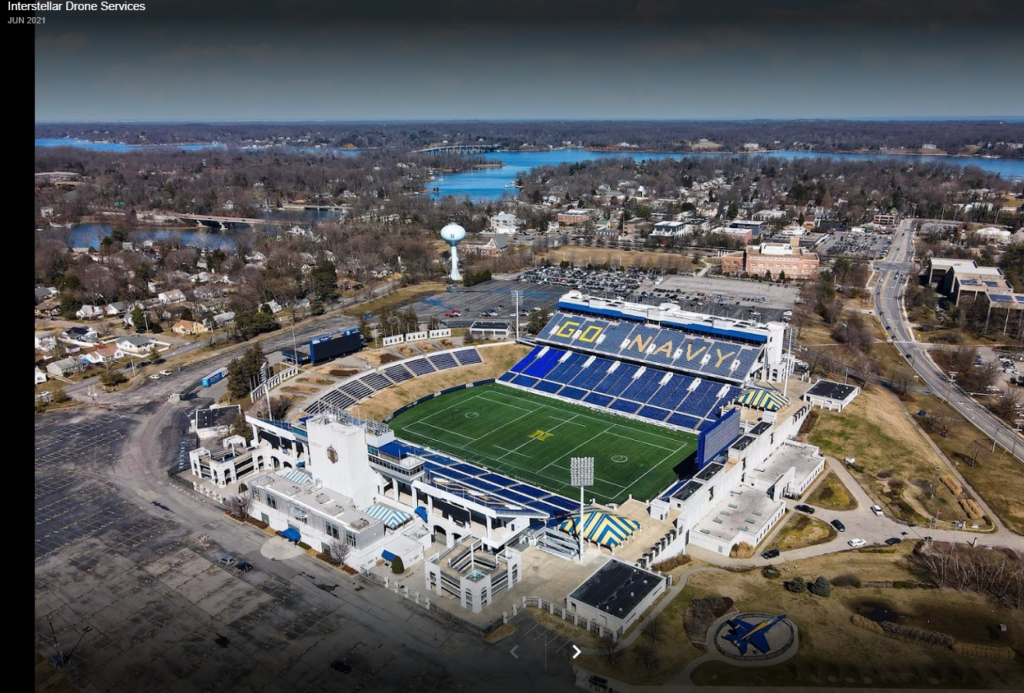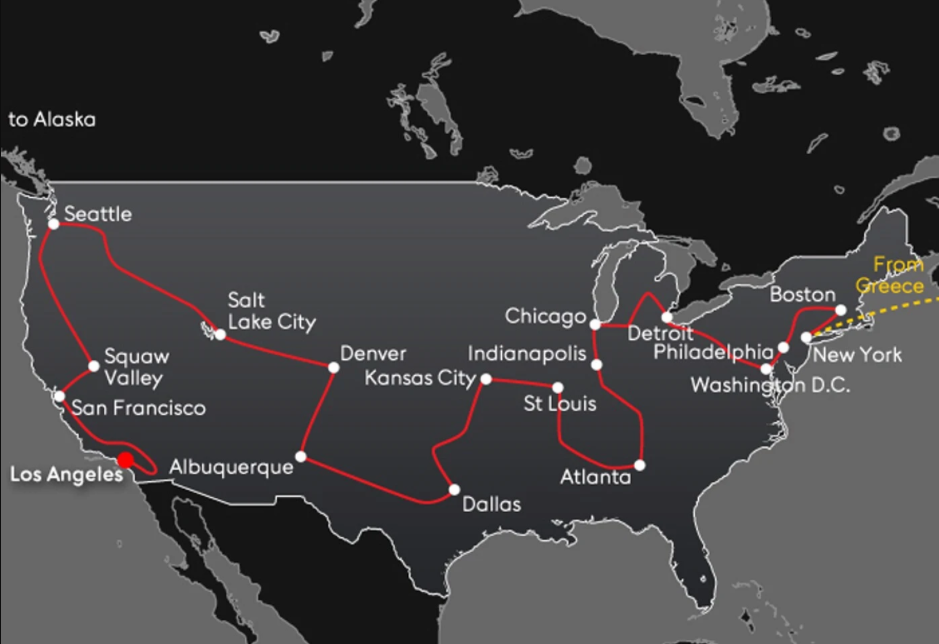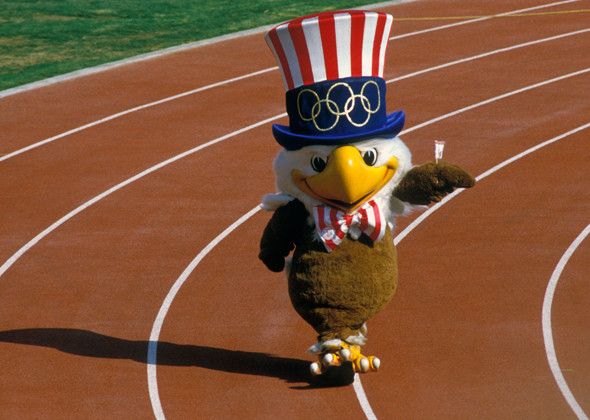Fifty two years after hosting the Olympic Games in 1932, Los Angeles became the first American city to twice be the host for the Summer Olympics. Four years earlier Lake Placid, NY became the first American city to host a pair of Olympic Games having held its first Winter Games in 1932. Now, let’s take a look at the
Games of the XXIII Olympiad,
for which Los Angeles was effectively the only bidder. This was a somewhat dark period for the Olympics. The 1972 Games in Munich suffered the attack by the Palestinian group Black September that slaughtered 11 Israeli athletes. Montreal’s Games in 1976 were a financial disaster for the host city and more than 60 countries had boycotted the 1980 games in Moscow. In fact, the only other city to submit a bid for the 1984 Games (that it later withdrew) was Teheran.
Security concerns and “chauvinistic sentiments and an anti-Soviet hysteria being whipped up in the United States” led the Soviet Union to announce its boycott of the Games on 8 May 1984. Thirteen countries later joined the Soviet boycott. (It’s interesting to note that more than 30 years after the Games, documents discovered in 2016 uncovered the USSR’s plans for a massive state sponsored doping program. This has led some to speculate that this was the true reason for the Soviet boycott.) Albania, Iran, and Libya also boycotted the Games though their reasons weren’t aligned with those of the USSR. In total, 6,289 athletes from 140 National Olympic Committees competed including 18 first time NOCs.
Annapolis, the capital of my home state of Maryland and a city I have visited often, played a part in the 1984 Olympics. The Rose Bowl in Pasadena hosted some preliminary round games and the medal round matches but the Navy-Marine Corps Memorial Stadium
[Photo from Interstellar Drone Services.]
was one of three sites outside the Los Angeles area (Harvard and Stanford Stadiums were the others) to host the preliminary rounds of the Olympic football (soccer) tournament. France, Qatar, Chile, Yugoslavia, Cameroon, Canada, and Iraq played in Annapolis.
The Olympic Torch Relay crossed the United States from east to west and passed through 33 states and the District of Columbia following the route below.
[Torch route map from Olympics.com.].
The route covered 15,000 kilometers (9,320.57 miles) with the torch carried by 3,636 runners. The first runners, Gina Hemphill and Bill Thorpe, Jr., the grandchildren of Jesse Owens and Jim Thorpe, carried the torch together for the first kilometer. Hemphill also carried the torch into the stadium where she handed it to Rafer Johnson (the 1960 decathlon gold medalist) who carried it up the stairs and became the first person of African descent to light the flame that would burn throughout the games. It burned in the same cauldron where the 1932 flame had burned.
Sam the Eagle, designed by Disney Creative Director of Marketing, replaced Smokey the Scottish Terrier as the Los Angeles mascot.
[Photo from Pinterest unidentified.]
The original choice had been a California Bear but the choice of Misha the bear by Moscow’s Olympic Committee in 1980 as the mascot for those Games moved L A in a different direction.
Synchronized swimming, rhythmic gymnastics, and wind surfing debuted as Olympic sports with baseball and tennis featured as demonstration sports.
Attendees and television watchers heard this John Williams composition for the first time:.
In gymnastics, Americans took advantage of the absence of boycotting teams as Mary Lou Retton became the first American to win the All-Around gold medal and the men’s team edged China and Japan for the team gold.
The U S won 21 of 30 swimming gold medals and Tiffany Cohen set a pair of Olympic records winning gold in the 400m and 800m freestyle demonstrating that Mark Spitz wasn’t the only Jew who was a great swimmer.
Greg Louganis followed his 1976 silver medal by winning both the 3 meter springboard and 10 meter platform.
The first gold medal awarded at the Games went to China’s Xu Haifeng in the 50m pistol. It was the first medal ever won by a Chinese athlete.
But most of the truly memorable action and images happened in athletics or track and field as we colloquially call it.
Thirty-seven year old Portuguese runner Carlos Lopes won the marathon in an Olympic record time of 2:09:21. Not only was this the first gold medal ever won for his country, the record stood until Samuel Wanjiru of Kenya shattered it by nearly three minutes in Beijing in 2008.
Women ran their first Olympic marathon and while Joan Benoit of the U S won the gold medal, perhaps the most lasting image is that of Swiss runner Gabriela Andersen-Schiess who explains here, what happened in the video below.
At a shorter distance, Sebastian Coe of Great Britain continued his dominance in the middle distance races by winning the 1500 meters. He became the first man to win consecutive gold medals in that event.
Edwin Moses, who had won the gold Medal in Montreal in 1976 and missed the 1980 Games because of the boycott repeated the feat in Los Angeles. It was part of a remarkable decade during which the American hurdler won 107 consecutive event finals while setting four world records.
Carl Lewis won gold medals in the 100m, 200m, 4x100m relay, and long jump duplicating Jesse Owens’ feat at the 1936 Berlin Olympics.
In women’s events, Nawal El Moutawakel of Morocco became the first female Olympic champion from any Muslim nation capturing gold in the 400m hurdles.
Evelyn Ashford and Valerie Brisco-Hooks helped the American women dominate the sprints. Although the Americans had no podium sweeps, they captured gold and silver in the 100, 200, and 400 meters. The Americans also won gold in both the 4×100 and 4×400 meter relays.
The American team won 40 medals in athletics 16 of them gold.
And I can’t leave you without one other lasting image from these Games in the women’s 3,000m race famous not for its winner (Maricica Puicǎ from Romania) but for the collision that happened between Zola Budd and Mary Decker several laps before the finish.
Remember, Decker had missed a chance for gold because of the 1980 boycott and was the prohibitive favorite in the race. Decker, who usually chose to run from the front eased up a bit in the middle of the race and actually allowed Budd to pass her.
Because she was from South Africa which was frequently barred from international competition, Budd was both an inexperienced runner and a rather controversial figure. She was able to run for Great Britain because one of her grandfathers was British.
Photographer David Burnett who managed to shoot an iconic image of Decker immediately after the fall, wrote in a 2020 article for Runner’s World,
The pain in Mary Decker’s face—so raw, and apparent—was something that almost should have remained the ultimate private moment. It was the anguish of a moment seen by 75,000 in the stadium, and millions around the world via television. Never have I witnessed such a raw public-private moment. When a young runner saw her Olympic dreams go up in smoke, you can easily imagine something astonishingly personal about it. Yet it was played out before the world. It became Mary’s worst day.



Carlos Lopes made History here! Thank you for your thorough coverage of the matter! It was great reading you!
Thank you, Ana. I so enjoyed our tour and all the information you provided about the history of Lisboa and Portugal. I’m happy to learn you have been reading and enjoying my posts and I hope I am returning the favor with this information.
I’m currently in Austria but when I return to the U.S., I’ll begin writing about Portugal. I expect to make the first posts at the beginning of August.